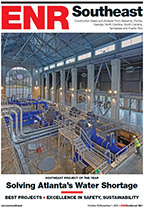The first major section of a 13.2-mile network of tunnels designed to help manage Washington, D.C.’s combined sewer overflows (CSOs) is taking shape beneath the Anacostia River, as the tunnel boring machine Lady Bird nibbles its way 24,300 lf from the District of Columbia Water and Sewer Authority (DC Water) Blue Plains Advanced Wastewater Treatment Plant to a major pumping station approximately one mile from the U.S. Capitol.
The tunnels are part of DC Water’s Clean Rivers Project, a long-term strategy to bring the District into compliance with Clean Water Act standards by capturing and treating at least 96 percent of the three billion gallons of raw and combined sewage that currently overflows from older sections of the District’s sewer system each year. As each tunnel is completed, overflows will be channeled to the Blue Plains plant, where a new a $470-million state-of-the-art anaerobic digester project is nearing completion.
Unlike other CSO projects underway in other parts of the country, however, bored tunnels are by and large the only option DC Water has to create its underground storage and conveyance network.
“In addition to the inherent challenges of a dense urban environment, our routes go through some of the most sensitive areas in the country—military installations, the White House Communications Center, and national security intelligence facilities,” explains Clean Rivers Project Director Carlton Ray. “Open-cut construction would be too intrusive, so we opted for bored tunnels.”
Since July 2013, the design-build joint venture of Traylor/Skanska/JayDee, supported by CH2M Hill/Halcrow, have guided Lady Bird more than 4,900 feet from its launching point at Blue Plains. Averaging more than 80 feet a day, the 400-ft long, 1,300-ton Herrenknecht-built machine is automatically installing and sealing the 12- to 14-in thick precast reinforced concrete panels that form the 23-ft diameter tunnel.
Thanks to the largely clay material that makes up the tunnel’s route more than 100 feet underground, “the mining conditions have been very good to date,” says Clean Waters Project Assistant Director Chris Allen.
The $330-million project also includes construction of two 192-ft deep shafts at Blue Plains in a “snowman” configuration. A 76-dia screening shaft, which also serves as an access point for Lady Bird’s operations, will filter storm debris from a 16-story, 250-MGD deep pump station to be constructed in the adjacent 132-ft dia shaft.
“The larger shaft has had the first of five incremental base slab pours completed for the 25-foot thick foundation, and much of the shaft’s waterproofing membrane has been installed,” Allen says.




Post a comment to this article
Report Abusive Comment